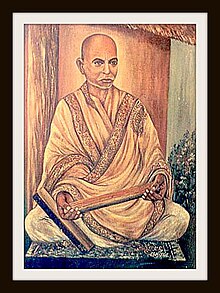Pathani Samanta
This article needs additional citations for verification. (October 2020) |
Pathani Samanta | |
|---|---|
ପଠାଣି ସାମନ୍ତ | |
 | |
| Born | 13 December 1835 |
| Died | 11 June 1904 (aged 67) |
| Known for | Astronomy |
Mahamahopadhyaya Chandrasekhara Singha Harichandana Mahapatra Samanta (Odia: ମହାମହୋପାଧ୍ୟାୟ ଚନ୍ଦ୍ରଶେଖର ସିଂହ ହରିଚନ୍ଦନ ମହାପାତ୍ର ସାମନ୍ତ), better known as Pathani Samanta (Odia: ପଠାଣି ସାମନ୍ତ), was an Indian astronomer and scholar who measured the distance from the Earth to the Sun with a bamboo pipe, and traditional instruments. He was born on 13 December 1835 in Purnimanta Pousha Krishna Ashtami, and died on 11 June 1904 in Purnimanta Adhika Jyeshtha Krishna Trayodashi.
His research and observations were compiled into a book called Siddhanta Darpana, which was written in both Sanskrit and the Odia script. He earned the Mahamahopadhyaya Award in 1893, for his usage of traditional instruments for astronomical observations.[1]
Biography[]
Samanta was born in the princely state of Khandpara, in the Nayagarh district of the Indian state of Odisha.[2] He was the son of Samanta Syamabandhu Singha and Bishnumali Devi. He was born into a royal family. He went on to study Sanskrit, and later researched traditional Indian astronomy.
During his youth, Samanta measured the length of the shadows throughout the day by using bamboo and wood to create measuring instruments, which he called mana yantra. He also measured time by using his version of a sundial.[3]
He was the only Indian astronomer who discovered all three irregularities of the moon independently of European astronomers, which were unknown to ancient Indian astronomers.[4]
Samanta suffered from insomnia throughout his life and died on June 11, 1904, from fever & infection. [5]
Instrument maker[]
Samanta was a self-taught astronomer, and learnt by reading the books available at the Royal Library until the age of 15. During his research, Samanta designed many of his instruments by using everyday materials such as wooden sticks and bamboo.[4] After studying mathematics and traditional astronomy he used his knowledge to match predictions made by ancient Indian mathematicians and astronomers such as Aryabhata, Varahamihira, and Brahmagupta.
He carried out research in measurements using only a bamboo pipe and two wooden sticks.[6] His findings were recorded in his book titled Siddhanta Darpana and were mentioned in the European and American press in 1899. Samanta’s calculations were eventually used in the preparation of almanacs in Odisha.
References[]
- ^ Naik, P. C.; Satpathy, L. (1998). "Samanta Chandra Sekhar : The great naked eye astronomer". Bulletin of the Astronomical Society of India. 26: 33–49. Bibcode:1998BASI...26...33N.
- ^ "EMINENT PERSONALITY".
- ^ Katti, Madhuri. "Chandrasekhar Samanta: India's Eye in the Sky". Live History India. Live History India. Retrieved 28 September 2020.
- ^ Jump up to: a b Panda, Bipin Bihari (2000). "PATHANI SAMANTA AND HIS THEORY OF PLANETARY MOTION" (PDF).
- ^ Katti, Madhuri. "Chandrasekhar Samanta: India's Eye in the Sky". Live History India. Live History India. Retrieved 28 September 2020.
- ^ "Samanta Chandrasekhar". Archived from the original on February 22, 2014.
Bibliography[]
- Satpathy, L., ed. (2003). "Samanta Chandra Sekhar and his Contributions to Ancient Indian Astronomy.". Ancient Indian Astronomy and Contributions of Samanta Chandra Sekhar. ISBN 9788173194320.
- Sriram, M. S.; Ramasubramanian, K.; Srinivas, M. D. (2002). "Samanta Chandra Sekhara and His Treatise Siddhantadarpana.". 500 years of Tantrasangraha: a landmark in the history of astronomy. p. 127. ISBN 9788179860090.
- 1835 births
- 1904 deaths
- 19th-century Indian astronomers
- Scientists from Odisha
- 20th-century Indian astronomers
- People from Nayagarh district
- Scholars from Odisha
